
1. Some basic clarifications:
A. How is watershed management integrated into water resource management?
Holistic Approach: Viewing the water cycle holistically, watershed management considers surface water, groundwater, soil moisture, and atmospheric water as interrelated components.
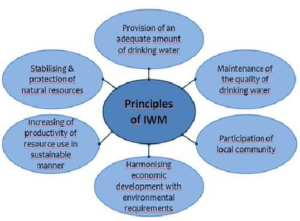
This integrated view fits the ideas of Integrated Water Resource Management (IWRM), which seeks to optimize economic and social welfare without endangering the sustainability of important ecosystems by means of coordinated development and management of water, land, and related resources.
Addressing Water Quantity and Quality: Watershed management addresses elements of water quality as well as quantity. Watershed management improves water availability, recharges groundwater, and lowers water pollution via soil and water conservation, afforestation, and sustainable land use.
This helps IWRM’s overarching objective to guarantee enough quantity and quality of water for many purposes, including domestic, agricultural, industrial, and environmental needs to be met.
Stakeholder Engagement: Good watershed management calls for the active involvement of many different stakeholders, including local governments, NGOs, businesses, and government agencies. Since it encourages cooperation, dispute resolution, and shared responsibility in water resource management, this multi-stakeholder approach is also fundamental in IWRM.
Adaptive Management: Adaptive management techniques used in watershed management change plans and methods depending on ongoing observation of results. This adaptable strategy conforms with the IWRM concept of adaptive management, which underlines the need to adjust to changing conditions, including population growth, economic development, and climate change, to guarantee the long-term sustainability of water resources.
Ecosystem-based Approach: Watershed management acknowledges the need to preserve healthy ecosystems for the provision of services connected to water. Watershed management advances the IWRM objective of maintaining the integrity of aquatic and terrestrial ecosystems by safeguarding and restoring natural habitats, including forests, wetlands, and riparian zones.
Addressing Multiple Water Uses: Watershed management takes into account the several water requirements of different sectors: agriculture, industry, household consumption, and the environment. This multifarious method conforms with the IWRM concept of harmonizing several water uses and fairly distributing water resources among conflicting needs.
B. Which aspects are covered under the area “water resource management”?
Planning and Development
-
Water Resource Planning: This involves assessing water availability and demand, and creating strategies for efficient allocation and use of water resources.
- Infrastructure Development: This includes the design and construction of water supply systems, irrigation facilities, and wastewater treatment plants.
Water Quality Management
- Pollution Control: Implementing measures to prevent and reduce contamination of water bodies from agricultural runoff, industrial discharges, and urban wastewater.
- Water Treatment: Ensuring that water is treated to meet safety standards for drinking and other uses.
Water Quantity Management
- Allocation and Distribution: Managing the distribution of water among various users, including agriculture, industry, and domestic use, while considering competing demands.
- Conservation Practices: Promoting techniques such as rainwater harvesting, efficient irrigation methods, and water recycling to optimize water use.
Regulatory Framework
- Policies and Regulations: Establishing legal frameworks and guidelines that govern water use, allocation, and protection of water resources.
- Water Rights: Defining and enforcing rights to water access and usage among different stakeholders.
Stakeholder Engagement
- Community Involvement: Encouraging participation from local communities, governments, and other stakeholders in decision-making processes to foster cooperation and sustainable practices.
- Education and Awareness: Raising awareness about the importance of water conservation and sustainable management practices among the public.
Integrated Water Resources Management (IWRM)
- Holistic Approach: Coordinating the management of water, land, and related resources to maximize economic and social welfare while ensuring ecosystem sustainability.
- Cross-Sectoral Planning: Integrating water management with land use planning, agriculture, urban development, and environmental conservation.
Monitoring and Evaluation
- Data Collection: Gathering data on water quality, quantity, and usage to inform management decisions.
- Performance Assessment: Evaluating the effectiveness of water management strategies and making necessary adjustments based on feedback and changing conditions.
Climate Change Adaptation
- Resilience Building: Implementing strategies to enhance the resilience of water resources to climate variability and extreme weather events, such as droughts and floods.
Research and Innovation
-
Technological Advancements: Utilizing new technologies and methodologies to improve water management practices, such as remote sensing and data analytics.
2. Historical background: A brief history of watershed management practices
Early Beginnings (18th–19th Centuries)
The idea of watershed management originated in the eighteenth century. History in India can be found in the building of reservoirs and tanks as well as in rising agricultural output to satisfy the needs of the rising population. Various kings came to see the need for village organizations and laws to control natural resources such as land, water, and vegetation.
Aiming to guarantee favorable circumstances for water flows, the Organic Administration Act of 1897 marked the beginning of congressional direction for managing forest reserves (today known as national forests) in the United States. In 1910, the U.S. Forest Service started watershed research at Wagon Wheel Gap, Colorado.
Mid-20th Century Developments
Officially, watershed improvement has been a three and a half half decade old activity in India; the first significant project started in 1973–1974. Launched the National Watershed Development Program for Rainfed Areas (NWDPRA), the idea gathered steam in the 1980s.
Important turning points in the development of watershed management policies in the Forest Service in the United States were the barometer watershed program in the 1960s and the Civilian Conservation Corps in the 1930s.
3. What is a watershed?
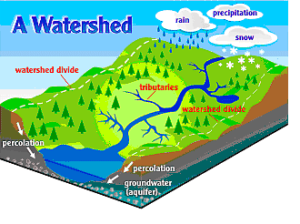
Defined by a natural limit called the water divide, a watershed is a clear geographic area where all surface water converges into one exit. Driven by its hydrological, biological, and topographical aspects, this natural unit of land is Small to large watersheds abound, their limits molded by the topography of the terrain.
From little creeks to vast river basins like the Mississippi River watershed, which covers over three million square kilometers, every body of water has a watershed that varies greatly in size. Size, drainage, form, and land use pattern all help to define a watershed.
- Macrowatershed (> 50,000 Ha)
- Sub-watershed (10,000 to 50,000 Ha)
- Milli-watershed (1000 to 10,000 Ha)
- Microwatershed (100 to 1000 Ha)
- Miniwatershed (1-100 Ha)
4. Watersheds: Naturally Occurring Systems
Natural geographic elements are watersheds. Designed over millions of years by erosion, deposition, and uplift, watersheds bear the permanent traces of Earth’s geological past. Rivers and streams cut their channels to define a watershed.
Humans can influence watersheds through activities like:
- Land use changes: Converting forests to agricultural lands, urbanization, and industrialization can alter the watershed’s hydrology and ecology.
- Dam construction: Dams can regulate water flow, create reservoirs, and impact downstream ecosystems.
- Pollution: Industrial, agricultural, and domestic waste can contaminate water bodies within a watershed.
- Climate change: altered precipitation patterns, increased temperatures, and more frequent extreme weather events can affect watershed processes.
Although people can greatly alter watersheds, it’s important to keep in mind that these are essentially natural processes. Rather than trying to recreate or artificially build watersheds, effective watershed management is knowing these natural processes and working with them.
5. What is watershed management?
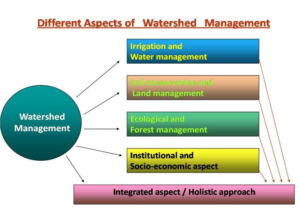
Watershed management is the process of implementing land use practices and water management practices to protect and improve the quality of the water and other natural resources within a watershed. The key objectives of watershed management are:
- Pollution control
- Minimising over-exploitation of resources
- Water storage, flood control, and checking sedimentation
- Wildlife preservation
- Erosion control and prevention of soil degradation
- Recharging groundwater to provide regular water supply
6. Facts and figures:
Here are some key facts and statistics related to watershed management:
- 40% of global watersheds are degraded. According to the United Nations Environment Programme (UNEP), a significant portion of the world’s watersheds are facing degradation, affecting their ability to provide essential ecosystem services and support human livelihoods.
- Improvement in water quality: The United States Environmental Protection Agency (EPA) notes that good watershed management may improve water quality by up to 70%. Maintaining recreational water bodies, supporting aquatic ecosystems, and assuring safe drinking water depend on this advancement.
- Economic returns on investment: The World Wildlife Fund (WWF) emphasizes that every dollar spent on watershed management can produce economic advantages ranging from $2 to $5. This return on investment emphasizes how financially feasible sustainable water resource management techniques are.
These statistics emphasize the critical importance of watershed management in addressing environmental degradation, improving water quality, and providing economic benefits to communities.
7. Significance of watershed management
Watershed management helps:
- Control pollution by reducing runoff of pollutants into water bodies
- Identify and regulate ecologically hazardous activities
- Enhance partnerships among stakeholders for effective management
- Achieve inclusive growth by increasing water availability and diversifying income sources
8. What are the differences between watershed and rainwater harvesting?
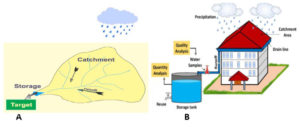
Watershed management is the whole method of controlling the whole watershed area, comprising all the land and water resources inside a certain drainage basin. Watershed management’s key objectives are to guarantee sustainable land use practices, reduce erosion, preserve and improve water quality, and therefore increase biodiversity. Important traits consist of:
- Scope: It encompasses a broader area, focusing on the interaction between land, water, and ecosystems.
- Objectives: It aims to manage water resources holistically, addressing issues like soil conservation, flood control, and habitat preservation.
- Methods: Involves practices such as reforestation, soil conservation techniques, and the construction of check dams to manage runoff and improve water retention in the landscape.
- Stakeholder Involvement: Often requires collaboration among various stakeholders, including government agencies, local communities, and environmental organizations, to implement integrated management plans.
B. Rainwater Harvesting
Conversely, a particular method meant for storing and using rainwater directly is rainwater collection. Where water is scarce, this approach is very helpful. Important attributes include:
- Scope: Focuses on the collection of rainwater from specific surfaces, such as rooftops or paved areas, for immediate use or groundwater recharge.
- Objectives: Primarily, it aims to provide an alternative water source, reduce dependence on traditional water supplies, and mitigate flooding by managing stormwater runoff.
- Methods: Involves various systems such as rooftop collection, storage tanks, and filtration systems to ensure the harvested water is clean and usable.
- Implementation: Typically implemented at the household or community level, it is a more localized approach compared to watershed management.
C. Summary of Differences
| Feature | Watershed Management | Rainwater Harvesting |
|---|---|---|
| Scope | Broad (entire watershed area) | Narrow (specific catchment areas) |
| Objectives | Holistic management of water resources | Capture and store rainwater |
| Methods | Erosion control, reforestation | Rooftop collection, storage tanks |
| Stakeholder Involvement | Collaborative among various stakeholders | Often individual or community-based |
Both methods are vital for sustainable water management, but they serve different purposes and are applied in different contexts to address water-related challenges effectively.
9. Why promote watershed management in the first place?
Watershed management is promoted primarily due to its multifaceted benefits for both ecological and human systems. The core reasons include:
A. Environmental Benefits:
- Soil and Water Conservation
Watershed management aims to control damaging runoff and degradation, thereby conserving soil and water resources. It involves implementing practices like terracing, contour farming, and afforestation to reduce erosion and enhance infiltration. - Utilization of Runoff Water
Watershed management promotes the management and utilization of runoff water for useful purposes, such as supplemental irrigation and groundwater recharge. Practices like rainwater harvesting and construction of check dams help capture and store water for later use. - Improving Land Productivity
By protecting, conserving and improving the land within a watershed, watershed management supports more efficient and sustained agricultural production. Measures like soil conservation and agroforestry enhance soil health and fertility. - Water Resource Protection
Watershed management focuses on protecting and enhancing the water resources originating within the watershed. This includes maintaining water quality, regulating water flow, and ensuring adequate water availability for various uses. - Flood and Drought Mitigation
Watershed management can help moderate flood peaks downstream by controlling runoff and promoting water storage. It also contributes to drought preparedness by enhancing groundwater recharge and improving water availability during dry periods. - Ecosystem Health and Biodiversity
By adopting an integrated approach to land, water and vegetation management, watershed management supports the health and resilience of ecosystems within the watershed. This includes protecting habitats, maintaining ecological balance, and enhancing biodiversity. - Sustainable Livelihoods
Effective watershed management can improve the socio-economic well-being of local communities by providing opportunities for income generation, sustainable livelihoods, and community development. This is achieved through measures like sustainable agriculture, agroforestry, and the development of water-based enterprises.
B. Socio-Economic Benefits
- Improved Livelihoods: Sustainable agriculture, forestry, and other economic activities can thrive in healthy watersheds, improving the livelihoods of local communities.
- Disaster Risk Reduction: By reducing the impact of floods and droughts, watershed management enhances community resilience.
- Rural Development: It contributes to overall rural development by providing access to clean water, infrastructure, and livelihood opportunities.
- Food Security: Increased agricultural productivity and stable water supply contribute to food security.
- Livelihood Enhancement: Watershed management can create job opportunities in sectors like forestry, agriculture, and ecotourism.
- Community Development: By involving local communities in watershed management, it fosters a sense of ownership and empowers them to address their needs.
C. Sustainable Development
- Resource Efficiency: Watershed management promotes the efficient use of water and land resources.
- Ecosystem Services: By preserving and restoring ecosystem functions, watershed management supports essential services like pollination, climate regulation, and water purification.
- Intergenerational Equity: Watershed management ensures that future generations inherit healthy ecosystems and sufficient water resources.
In essence, watershed management is a holistic approach that addresses multiple challenges simultaneously, making it a vital strategy for sustainable development and environmental protection.
10. How is watershed management different in urban vs. rural areas?
A. Urban Watershed Management
- Impervious Surfaces:
- Many impermeable surfaces—roads, parking lots, and buildings—that stop rainfall from seeping into the earth define urban regions. The fast runoff resulting from this raises the likelihood of flooding and erosion.
- Stormwater Infrastructure:
- Designed to rapidly transfer runoff away from built areas to prevent floods and property damage, cities have large stormwater management systems incorporating sewers, culverts, and detention basins.
- Pollution Control:
- Many times, including heavy metals, oils, and fertilizers, urban runoff can damage aquatic habitats. Urban watershed management thus gives pollution control measures—including green infrastructure, erosion control, and stormwater treatment devices—top priority.
- Regulatory Framework:
- Local, state, and federal authorities that specify the design, building, and maintenance of stormwater systems and best management practices (BMPs) for pollution control usually impose rigorous regulatory rules on urban areas.
- Complexity of Management:
- The great population density and the necessity to coordinate several parties, including municipal authorities, companies, and citizens, complicate the management of urban watersheds. Often, addressing water-related issues efficiently involves advanced planning and technology due to this complexity.
B. Rural Watershed Management
- Natural Landscapes:
- Usually consisting of agricultural fields, forests, and open places with less permeable surfaces, rural areas also include natural settings, agricultural activity, and rural roads, which create run-off from which diverse management requirements result.
- Less Developed Infrastructure:
- Usually lacking thorough stormwater control systems are rural areas. Rather, runoff is usually controlled by rivers, creeks, and natural drainage systems depending more on the capacity of the surroundings to absorb and filter water.
- Soil Conservation Focus:
- Rural watershed management stresses soil preservation techniques to lower erosion and nutrient runoff from farming operations. Often used are techniques including riparian buffers, cover cropping, and contour plowing.
- Collaborative Approaches:
- Good rural watershed management generally calls for cooperation among government agencies, farmers, landowners, and conservation organizations. These alliances seek to apply watershed-based management techniques meant to support sustainable land use.
- Lower Population Density:
- Generally speaking, rural places have less pollution than metropolitan areas, given that there are fewer people and less industrial activity. Still, agricultural activities can lead to non-point source pollution that calls for focused management initiatives.
11. How do different countries approach watershed management?
Different nations have different methods of managing their watersheds, influenced by local goals and conditions. Common elements are the need for stakeholder involvement, integrated management approaches, and a concentration on both environmental sustainability and community livelihoods.
Reflecting their own environmental, social, and financial settings, countries all around tackle watershed management in different ways. The following are some illustrations of various ways watershed management techniques are applied in different places:
United States
Watershed management in the United States sometimes proceeds from a cooperative, stakeholder-driven perspective. One outstanding example of how federal, state, and local governments collaborate with community organizations to apply a “pollution diet” meant to lower nutrient and sediment pollution is the Chesapeake Bay Watershed Restoration Project.
The Watershed Approach stresses public involvement, agency coordination, and identification of water quality issues as means of attaining ecological integrity and thereby bettering water quality.
India
Particularly with the start of the Namami Gange initiative meant to clean the Ganga River, India’s attitude to watershed management has changed dramatically. This program combines several approaches, including building sewage treatment plants, encouraging organic farming, and involving nearby populations in environmental preservation. The emphasis is on enhancing livelihoods by means of sustainable practices as well as on environmental recovery.
Brazil
Especially in the Atlantic Forest area, Brazil uses a participatory method of watershed management. To restore damaged areas and raise water quality, the government works with nearby towns, NGOs, and businesses. Demonstrating a dedication to both ecological and financial sustainability, initiatives might include reforestation, sustainable agriculture, and the creation of water funds financing conservation projects.
Australia
Murray-Darling Basin management in Australia is distinguished by a thorough and combined strategy for water resource control. The basin plan lays reasonable diversion restrictions to guarantee water supply for environmental as well as agricultural purposes. The strategy calls for investments in infrastructure to improve water quality and ecosystem health, water recovery projects, and the involvement of stakeholders.
South Africa
Watershed management is sometimes associated in South Africa with the management of water resources under conditions of water shortage. Emphasizing stakeholder involvement and the integration of social, economic, and environmental goals, the nation uses Integrated Water Resource Management (IWRM) concepts. Restoring wetlands and other catchment management techniques help to solve problems with water quality and volume.
China
The watershed management plans of China have progressively concentrated on sustainable development and ecological recovery. To safeguard important watersheds, the government has set ecological redlines and started massive afforestation initiatives. Particularly in areas suffering extreme water pollution and resource depletion, the strategy stresses the need to balance economic development with environmental protection.
Latin America
Watershed management in Latin America sometimes stresses community participation and local expertise. Usually emphasizing sustainable land use practices and the restoration of ecosystems, programs combine socio-economic development with environmental preservation. Commonly used collaborative governance systems let participants make decisions together.
12. Problems of watershed management
- Degradation of Natural Resources: Unsustainable exploitation of natural resources leads to degradation within watersheds. This includes soil erosion, loss of vegetation, and depletion of water quality and quantity. Over time, degradation diminishes the watershed’s value and its ability to provide essential ecosystem services.
- Urbanization and Land Development: Urban development sometimes disturbs natural water flow and adds contaminants to water supplies. Negative effects on water quality and ecosystem health follow from habitat loss, more impermeable surfaces resulting from urban growth, and chemical and waste contamination of the watershed.
- Competition and Conflict Among Stakeholders : Complicating watershed management are differences between upstream and downstream parties. Conflicting goals and demands might develop whereby upstream communities give agricultural expansion top priority while downstream towns concentrate on water quality and preservation. Tensions and poor management techniques might result from this lack of alignment.
- Interruption of Natural Water Flow: Natural water flow can be disrupted by human actions such as industrial water consumption, irrigation diversion, and dam building. Increasing soil erosion, habitat loss, and negative consequences on aquatic ecosystems follow from this disturbance. The health of the watershed depends on the natural flow patterns being maintained.
- Industrial Pollution: The growth of businesses within watersheds sometimes brings harmful toxins into water supplies, endangering human and animal life. Industrial discharges might contaminate sources of drinking water and destroy aquatic environments.
- Lack of Coordination and Integration: Many times, watershed management suffers from scattered governments and inadequate cooperation among several departments and stakeholders. This lack of integration might result in inefficient use of resources and poorly thought out development projects.
- Inadequate Infrastructure and Funding: Many watershed management initiatives deal with issues including insufficient finance and poor infrastructure. Lack of resources might make it difficult to carry out the required maintenance of facilities, the application of conservation policies, and the evolution of sustainable development.
- Climate Change Impacts: By changing precipitation patterns, raising the frequency of extreme weather events, and influencing water supply, climate change seriously complicates watershed management. These developments could aggravate already existing issues, including water quality deterioration, drought, and flooding.
13. Holistic approach to watershed management: Unique challenges
- Complexity of Watershed Systems: Good holistic management depends on including a wide spectrum of stakeholders. It can be difficult, though, to get significant involvement from all pertinent parties—local communities, government agencies, NGOs, and businesses. Divergent interests and priorities among stakeholders could compromise cooperation and decision-making.
- Stakeholder Engagement: Good holistic management depends on including a wide spectrum of stakeholders. It can be difficult, though, to get significant involvement from all pertinent parties—local communities, government agencies, NGOs, and businesses. Divergent interests and priorities among stakeholders could compromise cooperation and decision-making.
- Lack of Knowledge and Expertise: Professionals with the appropriate multidisciplinary knowledge and abilities needed for comprehensive watershed management are sometimes in limited supply. This disparity can hinder the creation of sensible management strategies and best practices’ application.
- Regulatory and Institutional Barriers: Since they generally concentrate on particular problems or sectors rather than combining several facets of watershed management, current regulatory systems may not be able to support comprehensive methods. Comprehensive strategy implementation is challenging when institutional fragmentation results in a lack of agency collaboration.
- Data Availability and Quality: Accurate and thorough data on watershed conditions, water quality, and stakeholder needs is what underlines good holistic management. Many times, data may be incomplete, out-of-date, or difficult to obtain, therefore impairing informed decision-making and adaptive management.
- Adaptive Management Challenges : Adaptive management—which calls for ongoing observation and assessment—is stressed in holistic approaches. Establishing strong monitoring systems and reacting properly to fresh data, however, can be logistically difficult and resource-intensive.
- Funding and Resource Constraints: Using a comprehensive strategy usually calls for large human resources as well as financial ones. Restricted funds can limit the capacity to carry out required assessments, apply management strategies, and properly involve stakeholders.
- Cultural and Social Barriers: Social factors and cultural attitudes might complicate overall watershed management. Communities may, for instance, have long-standing customs or ideas that contradict modern management techniques, which would complicate buy-in and cooperation.
14. Conclusion
Watershed management is quite important for both sustainable environmental stewardship and water security. Combining a thorough approach will enable us to address the numerous issues raised by industrial pressure, population growth, and climate change.
Good watershed management integrates scientific knowledge, community involvement, and legal systems to ensure the preservation and renewal of our water resources. It shows how closely ecosystems, human activities, and natural water cycles interact and suggests techniques for improving water quality, regulating water supply, and lower pollution by means of these interactions.
Ultimately, a well-managed watershed produces stronger communities, more resilient surroundings, and a sustainable future, thereby underscoring the need for ongoing cooperation and adaptable strategies suitable for local situations. As we proceed to safeguard water resources and maintain ecological equilibrium in our quickly changing environment, investing in comprehensive watershed management will be critically vital.
15. FAQs
1. What are the challenges in watershed management?
Challenges in watershed management include climate change, deforestation, pollution, population growth, and a lack of awareness. Additionally, securing funding and ensuring community participation can be difficult.
2. How does watershed management contribute to climate change mitigation?
Watershed management helps mitigate climate change by enhancing carbon sequestration through reforestation, reducing greenhouse gas emissions from deforestation, and improving water storage capacity.
3. What is the role of technology in watershed management?
Technology plays a crucial role in watershed management through remote sensing, Geographic Information Systems (GIS), and hydrological modeling. These tools help in monitoring water quality, predicting floods, and optimizing resource allocation.
4. How can communities participate in watershed management?
Communities can participate by forming watershed committees, planting trees, adopting sustainable farming practices, conserving water, and raising awareness about the importance of watersheds.
5. What are some successful watershed management case studies?
Several successful watershed management case studies can be found globally. These include the Chipko movement in India, the Alqueva Dam project in Portugal, and the Loess Plateau Watershed Management project in China.


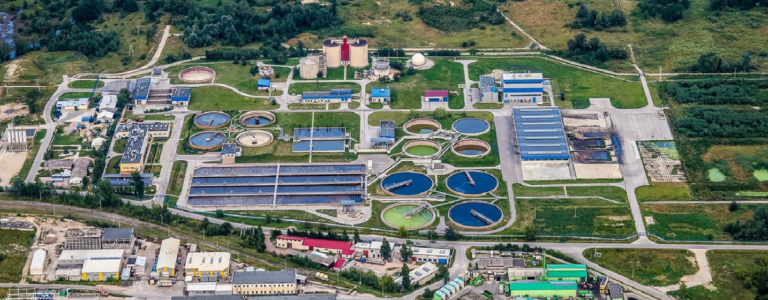

FinTech ZoomUs Pretty! This has been a really wonderful post. Many thanks for providing these details.
Glue Dream strain very informative articles or reviews at this time.
Thank you for your sharing. I am worried that I lack creative ideas. It is your article that makes me full of hope. Thank you. But, I have a question, can you help me?